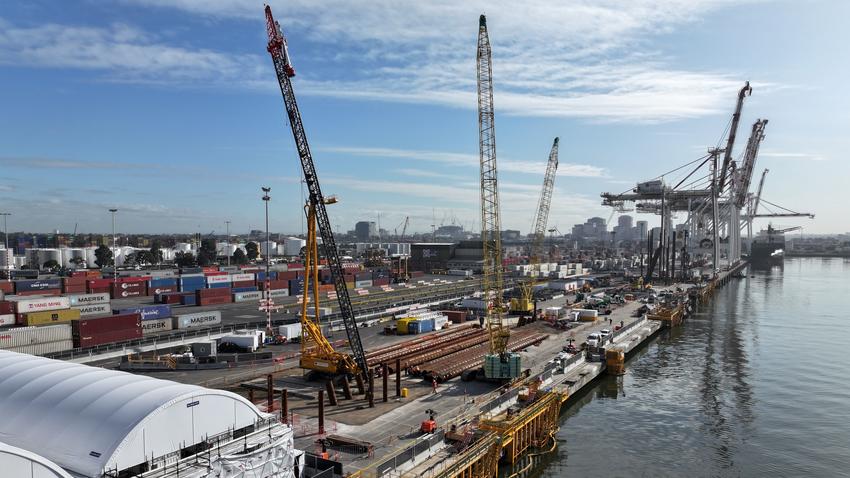Keller company Austral has completed a technically and logistically challenging project for the redevelopment of a historic dock at the Port of Melbourne – including installing the longest-ever raked piles in Australia.

Port of Melbourne is Australia’s largest general cargo and container port, handling more than a third of the nation’s shipping container trade. The sprawling site consists of several major docks, including Swanson Dock, which has been operatingfor more than half a century.
Over the past decade, Austral has completed numerous successful projects at the port for the head contractor , including at Swanson Dock East in 2019.
The latest project is the refurbishment of the ageing berth 1 on the dock’s west side, which has seen Austral install over 200 tubular steel piles.
Early involvement
The Keller company played a key role right from an early stage, helping the head contractor put together a robust package of design concepts, construction methods and costs that secured the contract. Austral was then selected for the foundation works.
“Our long-standing relationship with the head contractor , along with our technical expertise, marine experience and understanding of the site, helped us win this project,” says Callum Woodley, Construction Manager. “But what gave us a significant advantage over our competitors was our ability to install the 46m-long single length tubular steel piles, some on an incline, without the need to split them into segments.
“This meant we could complete the scope much more quickly and cost-effectively than our competitors.”
World’s largest rig
To achieve this extraordinary feat, Austral modified and strengthened its massive, 180-tonne Sennebogen 6100 HD-XLR piling rig. This specialist machine is the largest driven-piling rig in the southern hemisphere with a 60m mast that’s higher than the dock’s shipping cranes.
More than 160 tubular steel piles with 610mm diameters were installed vertically using the Sennebogen. A further 48 with 914mm diameters were installed on two different inclines (1:6 and 1:3).
Callum believes these are likely to be the longest and largest raked piles ever driven by a track-mounted piling rig in Australia – and possibly anywhere.
Having never installed such large piles before, the team carried out a simulated installation at Austral’s workshop, which gave them and the client the confidence that it could be achieved.
To ensure the Sennebogen’s safe operation on the existing wharf, a special bespoke grillage was created to distribute the machine’s high loads (1,000kPa-plus). Making this more challenging was the site’s small footprint and no-load areas. To load the piles into the machine, a restricted work zone of 60m was implemented to ensure no one was put at risk.
Detailed planning, communication and coordination with the client and other trades ensured the machine could move and carry out the works safely.
Working in a busy port
The unusually large machinery wasn’t the only challenge the team had to skillfully navigate. Due to the size of the piles, they couldn’t be transported by road, so had to be delivered by barge and stockpiled across the Yarra River at South Wharf and Appleton Dock. They were then shipped over to Swanson when needed – not an easy task considering this is one of Australia’s busiest ports.
“Because there are ships coming in and out all the time, obviously we couldn’t get in their way,” says Callum. “And if we hadn’t got deliveries across in time, it would have delayed our work, so everything had to be extremely well coordinated. We also had to pause the job several times a day to allow those ships to dock or set off. But ultimately, this was something we were able to successfully manage with the client and portlandlord , without disrupting port operations.”
An unexpected discovery
As well as logistical complexities, they also ran into some unexpected geological ones. At the northern end of the site, they encountered a high-strength layer of basalt, 15-20m below the wharf deck.
“Our equipment couldn’t penetrate it and this meant we weren’t able to install to the full design depth several of the piles,” he adds. “After consulting with our colleagues at Keller Australia, we proposed a rock-anchor solution to the head contractor and its designers.
“This involved cutting off the steel piles, and drilling through them using a standard rig to install the rock anchors. These were then thoroughly tested to ensure the gave us the correct compression capacity and tensile strength.”
A resounding success
Austral completed the project in May 2024, a year after starting, and Callum says that, despite the demands, it’s been a resounding success and Austral positioned strongly for the future works.
“The work was finished to the best possible standards, within the schedule and to the highest levels of safety. We’ve overcome many technical and logistical challenges and, with the length of the piles, achieved something we’ve not done before. The client and the port have expressed their appreciation for our efforts and we hope to work with them again on future stages to prolong the life of this important dock.”